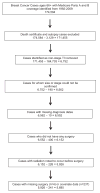Breast conservation versus mastectomy for patients with T3 primary tumors (>5 cm): A review of 5685 medicare patients
- PMID: 26479066
- PMCID: PMC4707052
- DOI: 10.1002/cncr.29726
Breast conservation versus mastectomy for patients with T3 primary tumors (>5 cm): A review of 5685 medicare patients
Abstract
Background: Although breast conservation therapy (BCT) is standard for breast cancer treatment, patients with tumors measuring >5 cm have been excluded from clinical trials. Nevertheless, only a few small retrospective series to date have compared BCT with mastectomy for tumors measuring >5 cm. The current study was performed to determine whether survival is equivalent for BCT versus mastectomy using a large national data set.
Methods: Surveillance, Epidemiology, and End Results (SEER)-Medicare-linked cases were identified for patients aged ≥ 66 years undergoing breast conservation for invasive, noninflammatory, nonmetastatic breast cancer between 1992 and 2009. Propensity score-based adjustment was used to account for demographics and tumor and treatment factors.
Results: A total of 5685 patients with tumors measuring >5.0 cm underwent breast surgery, with 15.6% receiving BCT. Mean ages of the patients and tumor sizes were similar. Predictors of BCT included neoadjuvant chemotherapy and postoperative radiotherapy use, higher income, breast cancer as a first malignancy, and a higher Charlson Comorbidity Index. Predictors of mastectomy included younger age, nonductal histology, higher grade, numbers of lymph nodes examined and found to be positive, American Joint Committee on Cancer stage III disease, postoperative chemotherapy use, and residential region of the country. Adjusted overall and breast cancer-specific survival were not different between patients treated with BCT and mastectomy (hazard ratio, 0.934; 95% confidence interval, 0.791-1.103 [P = .419] for overall survival; and subdistribution hazard ratio, 1.042; 95% confidence interval, 0.793-1.369 [P = .769] for breast cancer-specific survival), with each improving over time. The median follow-up was 7.0 years.
Conclusions: For Medicare patients with tumors measuring >5 cm, survival is similar between those treated with BCT and mastectomy as for patients with smaller primary tumors. Despite exclusion from randomized trials, BCT may remain an option for patients with larger tumors when deemed clinically and cosmetically amenable to surgical resection.
Keywords: breast cancer; breast mortality; breast neoplasms; breast pathology; breast radiotherapy; breast surgery; breast-conserving surgery; clinical practice patterns; feasibility studies; segmental mastectomy; survival rate; treatment outcome.
© 2015 American Cancer Society.
Figures




References
-
- Fisher B, Anderson S, Bryant J, et al. Twenty-year follow-up of a randomized trial comparing total mastectomy, lumpectomy, and lumpectomy plus irradiation for the treatment of invasive breast cancer. New England Journal of Medicine. 2002;347:1233–1241. - PubMed
-
- Fisher B, Bryant J, Wolmark N, et al. Effect of preoperative chemotherapy on the outcome of women with operable breast cancer. Journal of Clinical Oncology. 1998;16:2672–2685. - PubMed
-
- Gradishar WJ, Anderson BO, Balassanian R, et al. Breast Cancer. v.1.2015. NCCN; 2015. NCCN Clinical Practice Guidelines in Oncology; p. 184.
-
- Arriagada R, Le MG, Rochard F, Contesso G. Conservative treatment versus mastectomy in early breast cancer: patterns of failure with 15 years of follow-up data. Institut Gustave-Roussy Breast Cancer Group. Journal of Clinical Oncology. 1996;14:1558–1564. - PubMed
Publication types
MeSH terms
Grants and funding
LinkOut - more resources
Full Text Sources
Other Literature Sources
Medical

